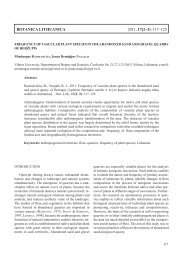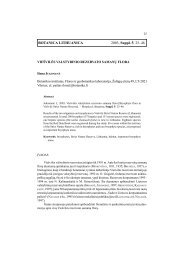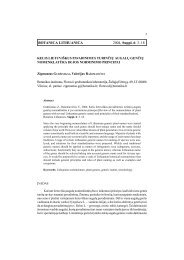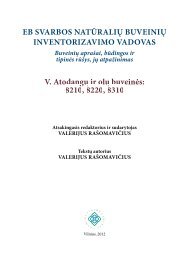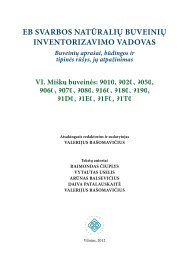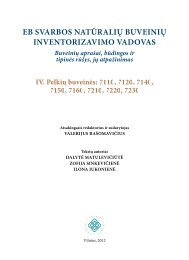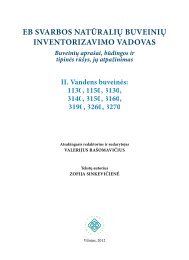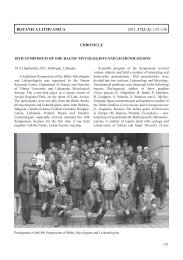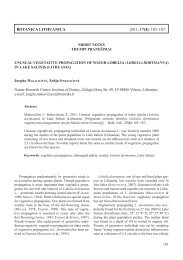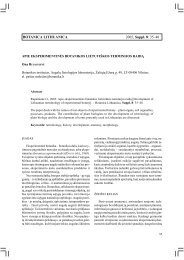FUNGI AND LICHENS IN THE BALTICS AND BEYOND XVIII ...
FUNGI AND LICHENS IN THE BALTICS AND BEYOND XVIII ...
FUNGI AND LICHENS IN THE BALTICS AND BEYOND XVIII ...
You also want an ePaper? Increase the reach of your titles
YUMPU automatically turns print PDFs into web optimized ePapers that Google loves.
production of conidia (a single conidium, true chain or a pseudochain) are the most important<br />
factors for identification of causal agent of mildew.<br />
New tendencies of systematics have been illustrated by identification of two<br />
comparatively new Erysiphales genera in Latvia.<br />
Mildew of strawberries was noted first in 2007 in an open field in Latvia, but regular<br />
observations were started in 2008 in the Research and Study farm “Vecauce” of the Latvia<br />
University of Agriculture (Jarmolica, Bankina, 2009). Causal agent of strawberry mildew<br />
belongs to genus Podosphaera according to present systematics (previous name<br />
Sphaerotecha). Chasmothecia of Podosphaera contain single ascus, appendages are hyphalike<br />
and conidia form true chains. Two species were mentioned (P. aphanis and P. macularis)<br />
as causal agents of strawberry mildew, these pathogens do not differ in morphological<br />
features, but P. aphanis was described as the most important pathogen in UK and other<br />
countries.<br />
Since 2006 symptoms of powdery mildew have been detected on rhododendron in<br />
Latvia. In the summer of 2009 several collections of rhododendrons have been inspected in<br />
different regions of Latvia to identify the pathogen and evaluate the spread of the disease<br />
(Bankina et al., in press). Symptoms differed depending on rhododendron variety: white<br />
mycelium covered the surface of upper or lower leaves or only purple blotch on the leaves<br />
were observed during first stage of infection. Chasmothecia contained several asci, they had<br />
more than 20 short, equatorial, hyaline appendages. Branching of appendages was regular,<br />
dichotomous. Conidia were ellipsoid-cylindrical, formed singly. The fungus was identified as<br />
Erysiphe azaleae (U. Braun) U. Braun & S. Takam according to morphological and<br />
anatomical characteristics (previous name Microsphaera azalea).<br />
<strong>FUNGI</strong> COLLECTED <strong>IN</strong> RIGA FROM <strong>THE</strong> COLLECTION OF <strong>THE</strong> NATURAL<br />
HISTORY MUSEUM OF LATVIA<br />
I. DANIELE, D. MEIERE<br />
Natural History Museum of Latvia, K. Barona Str. 4, LV-1050 Riga, Latvia<br />
E-mails: inita.daniele@ldm.gov.lv, diana.meiere@ldm.gov.lv<br />
Collection of macroscopic fungi of the Natural History Museum of Latvia consists of<br />
6594 units, and 665 specimens belonging to 402 species are from the territory of Riga City.<br />
Most of specimens are occasional collections of the specialists of the museum or have been<br />
brought to the museum by visitors for the identification. There is variety of different biotopes<br />
on the territory of Riga, they include parks, gardens, dunes, pine forests as well as deciduous<br />
and mixed forests. Lists of rare for Latvia species are given in the abstract.<br />
Rare species on old deciduous trees, dead wood and stumps in gardens and parks of<br />
Riga: Aleurodiscus disciforme, Artromyces pyxidatus, Fistulina hepatica, Flammulina<br />
velutipes, Grifola frondosa, Hapalopilus croceus, Hericium clathroides, Hypsizygus<br />
ulmarius, Pleurotus calyptratus, Pleurotus cornucopiae, Pluteus luteovirens, Pluteus pellitus,<br />
Ramicola centunculus, Volvariella bombycina, Xerula radicata.<br />
Rare species in park lawns and gardens: Agaricus augustus, Agaricus macrosporus,<br />
Agaricus vaporarius, Agaricus xanthoderma, Arrhenia sphathulata, Boletus reticulatus,<br />
Calocybe carnea, Clitocybe inornata, Clitopilus scyphoides, Coprinus auricomus, Coprinus<br />
radians, Inocybe erubescens, Lepiota oreadiformis, Leucoagaricus holosericus,<br />
Leucoagaricus bresadola, Leucocoprinus cepistipes, Lepiota subincarnata, Limacella<br />
vinosorubescens, Xerocomus rubellus.



